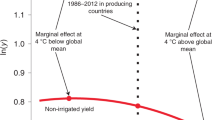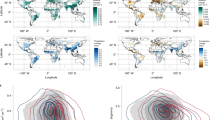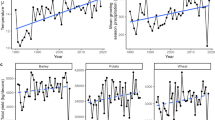Abstract
Annual food caloric production is the product of caloric yield, cropping frequency (CF, number of production seasons per year) and cropland area. Existing studies have largely focused on crop yield, whereas how CF responds to climate change remains poorly understood. Here, we evaluate the global climate sensitivity of caloric yields and CF at national scale. We find a robust negative association between warming and both caloric yield and CF. By the 2050s, projected CF increases in cold regions are offset by larger decreases in warm regions, resulting in a net global CF reduction (−4.2 ± 2.5% in high emission scenario), suggesting that climate-driven decline in CF will exacerbate crop production loss and not provide climate adaptation alone. Although irrigation is effective in offsetting the projected production loss, irrigation areas have to be expanded by >5% in warm regions to fully offset climate-induced production losses by the 2050s.
This is a preview of subscription content, access via your institution
Access options
Access Nature and 54 other Nature Portfolio journals
Get Nature+, our best-value online-access subscription
$29.99 / 30 days
cancel any time
Subscribe to this journal
Receive 12 print issues and online access
$209.00 per year
only $17.42 per issue
Buy this article
- Purchase on Springer Link
- Instant access to full article PDF
Prices may be subject to local taxes which are calculated during checkout





Similar content being viewed by others
Data availability
FAO national statistical data was obtained from http://www.fao.org/faostat/en/#data/QC. Agricultural TFP was obtained from the USDA ERS International Agricultural TFP dataset https://www.ers.usda.gov/data-products/international-agricultural-productivity/. The caloric conversion factor is based on the published dataset http://www.fao.org/docrep/003/X9892E/X9892e05.htm#P8217_125315. The bias-corrected climate model outputs are available at https://esg.pik-potsdam.de/search/isimip/.
Code availability
The scripts used to run the regression model are available through zenodo at: https://zenodo.org/record/7038556
References
Tilman, D., Balzer, C., Hill, J. & Befort, B. L. Global food demand and the sustainable intensification of agriculture. Proc. Natl Acad. Sci. USA 108, 20260–20264 (2011).
Mueller, N. D. et al. Closing yield gaps through nutrient and water management. Nature 490, 254–257 (2012).
Hong, C. et al. Global and regional drivers of land-use emissions in 1961–2017. Nature 589, 554–561 (2021).
Laurance, W. F., Sayer, J. & Cassman, K. G. Agricultural expansion and its impacts on tropical nature. Trends Ecol. Evol. 29, 107–116 (2014).
Cassman, K. G. & Grassini, P. A global perspective on sustainable intensification research. Nat. Sustain. 3, 262–268 (2020).
Hodge, I., Hauck, J. & Bonn, A. The alignment of agricultural and nature conservation policies in the European Union. Conserv. Biol. 29, 996–1005 (2015).
Heilmayr, R., Rausch, L. L., Munger, J. & Gibbs, H. K. Brazil’s Amazon Soy Moratorium reduced deforestation. Nat. Food 1, 801–810 (2020).
Diffenbaugh, N. S. et al. Quantifying the influence of global warming on unprecedented extreme climate events. Proc. Natl Acad. Sci. USA 114, 4881–4886 (2017).
Iizumi, T. & Ramankutty, N. How do weather and climate influence cropping area and intensity? Glob. Food Security 4, 46–50 (2015).
Davis, K. F., Downs, S. & Gephart, J. A. Towards food supply chain resilience to environmental shocks. Nat. Food 2, 54–65 (2020).
Wang, X. et al. Emergent constraint on crop yield response to warmer temperature from field experiments. Nat. Sustain. 3, 908–916 (2020).
Lobell, D. B., Schlenker, W. & Costa-Roberts, J. Climate trends and global crop production since 1980. Science 333, 616–620 (2011).
Sloat, L. L. et al. Climate adaptation by crop migration. Nat. Commun. 11, 1243 (2020).
Afifi, T., Liwenga, E. & Kwezi, L. Rainfall-induced crop failure, food insecurity and out-migration in Same-Kilimanjaro, Tanzania. Clim. Dev. 6, 53–60 (2014).
Stigter, K. in Applied Agrometeorology (ed. Stigter, K.) 531–534 (Springer, 2010).
Seifert, C. A. & Lobell, D. B. Response of double cropping suitability to climate change in the United States. Environ. Res. Lett. 10, 024002 (2015).
Kawasaki, K. Two harvests are better than one: double cropping as a strategy for climate change adaptation. Am. J. Agr. Econ. 101, 172–192 (2019).
Ceglar, A., Zampieri, M., Toreti, A. & Dentener, F. Observed northward migration of agro‐climate zones in Europe will further accelerate under climate change. Earths Future 7, 1088–1101 (2019).
Cohn, A. S., VanWey, L. K., Spera, S. A. & Mustard, J. F. Cropping frequency and area response to climate variability can exceed yield response. Nat. Clim. Change 6, 601–604 (2016).
Challinor, A. J., Simelton, E. S., Fraser, E. D. G., Hemming, D. & Collins, M. Increased crop failure due to climate change: assessing adaptation options using models and socio-economic data for wheat in China. Environ. Res. Lett. 5, 034012 (2010).
Ray, D. K. & Foley, J. A. Increasing global crop harvest frequency: recent trends and future directions. Environ. Res. Lett. 8, 044041 (2013).
Wu, W. et al. Global cropping intensity gaps: increasing food production without cropland expansion. Land Use Policy 76, 515–525 (2018).
Pugh, T. A. M. et al. Climate analogues suggest limited potential for intensification of production on current croplands under climate change. Nat. Commun. 7, 12608 (2016).
Scherer, L. A., Verburg, P. H. & Schulp, C. J. E. Opportunities for sustainable intensification in European agriculture. Glob. Environ. Change 48, 43–55 (2018).
Qin, Y. et al. Agricultural risks from changing snowmelt. Nat. Clim. Change 10, 459–465 (2020).
Waha, K. et al. Multiple cropping systems of the world and the potential for increasing cropping intensity. Glob. Environ. Change 64, 102131 (2020).
Raderschall, C. A., Vico, G., Lundin, O., Taylor, A. R. & Bommarco, R. Water stress and insect herbivory interactively reduce crop yield while the insect pollination benefit is conserved. Glob. Chang. Biol. 27, 71–83 (2021).
Ding, M. et al. Variation in cropping intensity in Northern China from 1982 to 2012 based on GIMMS-NDVI data. Sustainability 8, 1123 (2016).
Yu, Q., Xiang, M., Sun, Z. & Wu, W. The complexity of measuring cropland use intensity: an empirical study. Agr. Syst. 192, 103180 (2021).
Moore, F. C. & Lobell, D. B. Adaptation potential of European agriculture in response to climate change. Nat. Clim. Change 4, 610–614 (2014).
Agnolucci, P. et al. Impacts of rising temperatures and farm management practices on global yields of 18 crops. Nat. Food 1, 562–571 (2020).
Zhu, P. & Burney, J. Temperature‐driven harvest decisions amplify US winter wheat loss under climate warming. Glob. Change Biol. 27, 550–562 (2021).
Ortiz-Bobea, A., Knippenberg, E. & Chambers, R. G. Growing climatic sensitivity of U.S. agriculture linked to technological change and regional specialization. Sci. Adv. 4, 4343 (2018).
Duku, C., Zwart, S. J. & Hein, L. Impacts of climate change on cropping patterns in a tropical, sub-humid watershed. PLoS ONE 13, 0192642 (2018).
Folberth, C. et al. The global cropland-sparing potential of high-yield farming. Nat. Sustain. 3, 281–289 (2020).
Lobell, D. B. et al. The critical role of extreme heat for maize production in the United States. Nat. Clim. Change 3, 497–501 (2013).
Yang, X. et al. Potential benefits of climate change for crop productivity in China. Agric. For. Meteorol. 208, 76–84 (2015).
Burney, J., Woltering, L. & Burke, M. Solar-powered drip irrigation enhances food security in the Sudano–Sahel. Proc. Natl Acad. Sci. USA 107, 1848–1853 (2010).
You, L. et al. What is the irrigation potential for Africa? A combined biophysical and socioeconomic approach. Food Policy 36, 770–782 (2011).
Zheng, B., Chenu, K., Fernanda Dreccer, M. & Chapman, S. C. Breeding for the future: what are the potential impacts of future frost and heat events on sowing and flowering time requirements for Australian bread wheat (Triticum aestivium) varieties? Glob. Change Biol. 18, 2899–2914 (2012).
Flach, R., Fader, M., Folberth, C., Skalský, R. & Jantke, K. The effects of cropping intensity and cropland expansion of Brazilian soybean production on green water flows. Environ. Res. Commun. 2, 071001 (2020).
Wood, S. A., Jina, A. S., Jain, M., Kristjanson, P. & DeFries, R. S. Smallholder farmer cropping decisions related to climate variability across multiple regions. Glob. Environ. Change 25, 163–172 (2014).
Paola, A. D. et al. The expansion of wheat thermal suitability of Russia in response to climate change. Land Use Policy 78, 70–77 (2018).
Brunelle, T. & Makowski, D. Assessing whether the best land is cultivated first: a quantile analysis. PLoS ONE 15, e0242222 (2020).
Lark, T. J., Spawn, S. A., Bougie, M. & Gibbs, H. K. Cropland expansion in the United States produces marginal yields at high costs to wildlife. Nat. Commun. 11, 4295 (2020).
Zabel, F., Putzenlechner, B. & Mauser, W. Global agricultural land resources—a high resolution suitability evaluation and its perspectives until 2100 under climate change conditions. PLoS ONE 9, e107522 (2014).
Petkeviciene, B. The effects of climate factors on sugar beet early sowing timing. Agron. Res. 7, 436–443 (2009).
Ainsworth, E. A. & Long, S. P. 30 years of free-air carbon dioxide enrichment (FACE): what have we learned about future crop productivity and its potential for adaptation? Glob. Change Biol. 27, 27–49 (2021).
Collins, M. et al. in Climate Change 2013: The Physical Science Basis (eds Stocker, T. F. et al.) Ch. 11 (Cambridge Univ. Press, 2013).
Pendergrass, A. G., Knutti, R., Lehner, F., Deser, C. & Sanderson, B. M. Precipitation variability increases in a warmer climate. Sci. Rep. 7, 17966 (2017).
Asadieh, B. & Krakauer, N. Y. Global trends in extreme precipitation: climate models versus observations. Hydrol. Earth Syst. Sci. 19, 877–891 (2015).
Zhang, Y., You, L., Lee, D. & Block, P. Integrating climate prediction and regionalization into an agro-economic model to guide agricultural planning. Clim. Change 158, 435–451 (2020).
Turner, S. W. D., Hejazi, M., Yonkofski, C., Kim, S. H. & Kyle, P. Influence of groundwater extraction costs and resource depletion limits on simulated global nonrenewable water withdrawals over the twenty‐first century. Earths Future 7, 123–135 (2019).
Zhu, W., Jia, S., Devineni, N., Lv, A. & Lall, U. Evaluating China’s water security for food production: the role of rainfall and irrigation. Geophys. Res. Lett. 46, 11155–11166 (2019).
FAOSTAT (Food and Agriculture Organization of the United Nations, 1997).
Egli, L., Schröter, M., Scherber, C., Tscharntke, T. & Seppelt, R. Crop asynchrony stabilizes food production. Nature 588, E7–E12 (2020).
Hersbach, H. et al. ERA5 Hourly Data on Single Levels from 1979 to Present (Copernicus Climate Change Service (C3S) Climate Data Store (CDS), accessed 1 August 2020); https://doi.org/10.24381/cds.adbb2d47 (2018).
Feng, P. et al. Impacts of rainfall extremes on wheat yield in semi-arid cropping systems in eastern Australia. Clim. Change 147, 555–569 (2018).
Teluguntla, P. et al. in Land Resources Monitoring, Modeling, and Mapping with Remote Sensing (ed. Thenkabail, P. S.) 849 (CRC Press, 2015).
Hawkins, E. et al. Increasing influence of heat stress on French maize yields from the 1960s to the 2030s. Glob. Change Biol. 19, 937–947 (2013).
Friedman, J., Hastie, T. & Tibshirani, R. Regularization paths for generalized linear models via coordinate descent. J. Stat. Softw. 33, 1–22 (2010).
Lobell, D. B., Bänziger, M., Magorokosho, C. & Vivek, B. Nonlinear heat effects on African maize as evidenced by historical yield trials. Nat. Clim. Change 1, 42–45 (2011).
Deryng, D., Sacks, W. J., Barford, C. C. & Ramankutty, N. Simulating the effects of climate and agricultural management practices on global crop yield. Glob. Biogeochem. Cycles 25, GB2006 (2011).
New, M., New, M., Lister, D., Hulme, M. & Makin, I. A high-resolution data set of surface climate over global land areas. Clim. Res. 21, 1–25 (2002).
Willmott, C. J. Terrestrial Air Temperature and Precipitation: Monthly and Annual Time Series (1950–1996) (Center for Climatic Research, 2000); http://climate.geog.udel.edu/~climate/html_pages/README.ghcn_ts2.html
Van Beveren, I. Total factor productivity estimation: a practical review. J. Econ. Surv. 26, 98–128 (2012).
Xu, J. et al. Double cropping and cropland expansion boost grain production in Brazil. Nat. Food 2, 264–273 (2021).
Friedl, M. & Gray, J. MCD12Q2 MODIS/Terra+ Aqua Land Cover Dynamics Yearly L3 Global 500 m SIN Grid V006 (NASA EOSDIS, 2019).
Sulla-Menashe, D. & Friedl, M. A. User Guide to Collection 6 MODIS Land Cover (MCD12Q1 and MCD12C1) Product (USGS, 2018).
Schwalm, C. R., Glendon, S. & Duffy, P. B. RCP8.5 tracks cumulative CO2 emissions. Proc. Natl Acad. Sci. USA 117, 19656–19657 (2020).
Lange, S. Trend-preserving bias adjustment and statistical downscaling with ISIMIP3BASD (v1.0). Geosci. Model Dev. 12, 3055–3070 (2019).
Peng Zhu. Climate effects on caloric yield and cropping frequency. Zenodo https://doi.org/10.5281/zenodo.7038556 (2022).
Acknowledgements
P.Z. and P.C. are supported by the CLAND project (grant no. 16-CONV-0003) and ISIPEDIA: The Open Inter-Sectoral Impacts Encyclopedia (grant no. ANR-17-ERA4-0006 - ISIPEDIA). D.M. is supported by the CLAND project (grant no. 16-CONV-0003) and meta-programme CLIMAE-INRAE. L.Y. is supported by Tsinghua University Initiative Scientific Research Programme (2021Z11GHX002, 20223080017). J.B. is supported by NSF/NIFA no. 1639318 INFEWS/T1. J.C. is supported by the National Key Research and Development Programme of China (2021YFE0114500). Q.X. is supported by National Key Research and Development Programme of China (grant no. 2017YFA0604300).
Author information
Authors and Affiliations
Contributions
P.Z. designed the study, performed the analysis and led the writing. J.B., J.C., Z.J., N. M., D.M. and P.C. helped the results interpretation. Q.X., J.X. and L.Y. provided additional data for comparison. All authors reviewed the manuscript and contributed to the manuscript writing.
Corresponding author
Ethics declarations
Competing interests
The authors declare no competing interests.
Peer review
Peer review information
Nature Climate Change thanks Avery Cohn, Katharina Waha and the other, anonymous, reviewer(s) for their contribution to the peer review of this work.
Additional information
Publisher’s note Springer Nature remains neutral with regard to jurisdictional claims in published maps and institutional affiliations.
Supplementary information
Supplementary Information
Supplementary Tables 1–6 and Figs. 1–19.
Rights and permissions
Springer Nature or its licensor (e.g. a society or other partner) holds exclusive rights to this article under a publishing agreement with the author(s) or other rightsholder(s); author self-archiving of the accepted manuscript version of this article is solely governed by the terms of such publishing agreement and applicable law.
About this article
Cite this article
Zhu, P., Burney, J., Chang, J. et al. Warming reduces global agricultural production by decreasing cropping frequency and yields. Nat. Clim. Chang. 12, 1016–1023 (2022). https://doi.org/10.1038/s41558-022-01492-5
Received:
Accepted:
Published:
Issue Date:
DOI: https://doi.org/10.1038/s41558-022-01492-5
This article is cited by
-
Unequal impact of climate warming on meat yields of global cattle farming
Communications Earth & Environment (2024)
-
Global land drought hubs confounded by teleconnection hotspots in equatorial oceans
npj Climate and Atmospheric Science (2024)
-
Fertilizer management for global ammonia emission reduction
Nature (2024)
-
Aquifer depletion exacerbates agricultural drought losses in the US High Plains
Nature Water (2024)
-
Recent advancements of nanotechnology in fish aquaculture: an updated mechanistic insight from disease management, growth to toxicity
Aquaculture International (2024)



